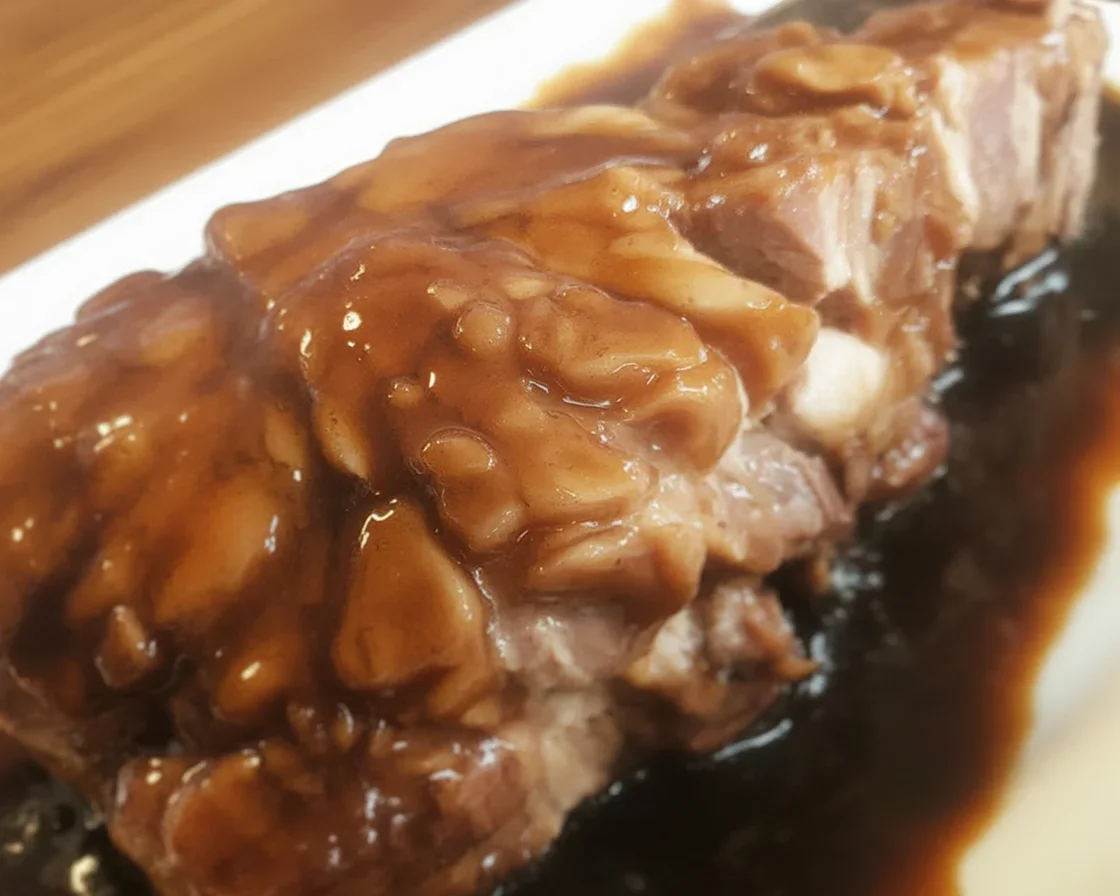Filipino pork asado. You know, sometimes you just get that craving for something savory for dinner, but you honestly can’t handle spending hours in the kitchen, fumbling with impossible recipes or expensive ingredients. If you’re like me, you want a meal that hits all the right comforting notes, is pretty simple to put together, and just makes the whole house smell… wow. Trust me, Filipino pork asado checks those boxes. If you’re into that sticky-sweet-glazed BBQ vibe, you might also love this Filipino pork BBQ with banana ketchup glaze or maybe for a twist, try homemade tocino Filipino sweet pork for another easy weeknight hit. 
What is pork asado?
Alright, let me just clear something up: Filipino pork asado is not that crazy red steamed pork bun from Chinatown (though those are tasty, too). Nope, this dish is something you’d find simmering away in your Lola’s kitchen. Pork asado in the Filipino style is basically pork braised—yeah, just cooked in a sauce until everything’s meltingly soft, and the flavors practically tackle you. Sweet, salty, sometimes gingery, with a little soy sauce and star anise hanging out in there.
It’s the kind of thing you start for Sunday lunch and—oh, wait, you’re too hungry? You can eat it for weeknight dinner, too. The thing is, every family chops and tweaks the recipe. Some people toss in potatoes, carrots, or even pineapple for fun. Others keep it classic, letting the honest pork flavor shine through. The star is the pork itself: juicy, fall-apart tender, all dressed up in rich, dark sauce.
No joke, I use this recipe for those times I’ve got family crashing over or friends dropping by. They might not leave, fair warning. 
Ingredients list
OK, so you’re standing in the grocery store. Don’t panic. Here’s what you need for Filipino pork asado (really, nothing fancy):
- Pork belly or pork shoulder (about 2 lbs, cut into big chunks, not too tiny)
- Garlic (and use extra if you’re obsessed, like me)
- Soy sauce (the salty superhero)
- Brown sugar
- Bay leaves
- Black peppercorns or cracked black pepper
- Star anise (not always, but wow, it really zings)
- Optional: onions (sliced), potatoes, carrots, pineapple chunks
- Cooking oil
- Water (or broth, if you’re feeling snazzy)
- A good dash of vinegar or lemon juice, if you like a little tang
That’s it. Seriously, nothing weird or expensive. If you want to prep for a full-on Filipino feast, you can pair it with classic garlic sinangag, or even try a Filipino breakfast silog combo.
Cooking pork until tender
Getting the pork just right is non-negotiable for Filipino pork asado. This step is my little test of patience—a test I usually fail when I’m too hungry, but hang in there! First, you brown those pork chunks in a big pot with hot oil. Just let the edges go a little crispy (and yeah, some bits will stick, that’s flavor).
When the pork looks golden-ish, you toss in all your garlic (again, don’t hold back). Stir until the kitchen smells like you suddenly know what you’re doing. Next, pour in your soy sauce, water or broth (enough to almost cover the pork), toss in those bay leaves, sprinkle in the black pepper, and add that sneaky star anise if you’re brave. Bring it to a boil and then… here’s the part I always mess up… turn the heat waaay down. Just cover and simmer. Walk away. Let it hang out for about 45 minutes or more, until the pork is so tender you can break it with a fork.
“I never thought I could make my grandma’s Filipino pork asado taste this close! The pork basically falls apart and the sauce is better than any restaurant.” – Liza, Nebraska
Preparing the sauce
Once the pork is soft (seriously, check by poking it), the magic happens with the sauce. Some folks scoop out the pork and let the sauce cook down to thicken. Me? I’m impatient, so I just sprinkle in the brown sugar straight into the pot while the pork is still in there.
Now’s the time for a little taste test—always, always taste. Sometimes it needs more sugar, or maybe a swig more soy sauce. If you want a brighter flavor, a dash of lemon or vinegar can wake everything up. The sauce should coat a spoon but not turn into syrup. It’s OK if it’s a little runny, you’ll need it for drizzling over rice.
Oh, and my cousin secretly throws in a splash of pineapple juice—gives it that something-something. No judgment.
Combining and simmering
With the sauce sorted out, everything needs a bit more time to come together—like a last-minute team huddle. I usually just let it simmer open so the sauce gets thick enough to hug the pork, but not dry. If you tossed in potatoes or carrots, they’ll soften up, too. Keep the heat nice and low. Walk by, give it an occasional stir. Don’t rush. This is where Filipino pork asado turns from good to “wait, you cooked this??”
Eventually, the sauce should look glossy and stick to the pork real nice. If it looks too thin, crank up the heat (just for a minute) and let things bubble.
Best side dishes
Serving Filipino pork asado without rice? I mean… it’s illegal somewhere, probably. Here’s what my family likes:
- Steaming hot white rice (absolute must, trust me)
- Garlic sinangag (Filipino garlic fried rice if you’re feeling fancy)
- Quick pickled cucumbers or atchara (for that perfect sour crunch)
- Simple sautéed spinach or steamed green beans (because, balance)
If you wanna impress, try it with a breakfast silog combo. Or just pile everything on one plate—no one’s judging.
Storage tips
Good news: Filipino pork asado tastes even better the next day. Seriously, let the sauce sit overnight and you’ll see. Store any leftovers in a tight container in the fridge (it’ll last up to three days but that’s optimistic, honestly—my family never leaves leftovers that long). Pop it back in a saucepan or microwave, splash a bit of water in so it doesn’t dry up, and warm it gently. Oh, and you can freeze it too, in case you get ambitious and make a double batch.
Common Questions
Q: Can I use chicken instead?
A: For sure! Just cut the cooking time shorter since chicken cooks faster than pork—maybe 30 minutes. The sauce still rocks.
Q: What cut of pork is best?
A: Pork belly is unbeatable for richness, but shoulder is cheaper and still juicy. Don’t use lean cuts—they dry out.
Q: Can I make this ahead for parties?
A: Totally. Filipino pork asado is like stew—it tastes even better after it’s rested in the fridge overnight.
Q: How do I make it “healthier” (my doctor asked, sigh)?
A: Trim off extra fat, use leaner cuts, maybe add more carrots or even substitute some pork with tofu. Check out healthy Filipino recipes for more tweaks.
Q: My sauce is too salty—now what?
A: Add water or a pinch more sugar. Or serve it with extra rice (kids never complain about that, right?).

Alright, so that’s my whole spiel on Filipino pork asado. It’s honestly the kind of thing that never disappoints—even picky eaters get a little glow in their eyes. For more ideas and inspo, the classic Pork Asado Recipe breaks it down step by step, or check out how other folks are making Filipino pork asado recipe on Reddit’s r/asianeats for extra tips. Whether it’s your first time or your fiftieth, give this a go. And—just warning you—don’t expect leftovers!
Filipino Pork Asado
Ingredients
Main Ingredients
- 2 lbs Pork belly or pork shoulder, cut into big chunks Pork belly is richer; shoulder is more affordable.
- 4 cloves Garlic, minced Use extra if desired.
- 1/2 cup Soy sauce The salty base of the sauce.
- 1/4 cup Brown sugar Adds sweetness to balance the saltiness.
- 3 leaves Bay leaves For added flavor.
- 1 teaspoon Black peppercorns or cracked black pepper
- 1 piece Star anise (optional) Adds a warm flavor.
- 3 tablespoons Cooking oil For browning the pork.
- 2 cups Water or broth Use enough to almost cover the pork.
- 1 tablespoon Vinegar or lemon juice (optional) For a tangy flavor.
- 1 cup Onions, sliced (optional) For added sweetness.
- 1 cup Potatoes, cubed (optional) Adds heartiness.
- 1 cup Carrots, sliced (optional) Adds sweetness.
- 1 cup Pineapple chunks (optional) For a sweet twist.
Instructions
Cooking the Pork
- Brown the pork chunks in a large pot with hot oil until the edges are crispy.
- Add minced garlic and stir until fragrant.
- Pour soy sauce and enough water or broth to almost cover the pork. Add bay leaves, black pepper, and star anise.
- Bring to a boil, then reduce heat, cover, and simmer for about 45 minutes or until tender.
Preparing the Sauce
- Once the pork is tender, add brown sugar directly into the pot.
- Taste the sauce and adjust sweetness or acidity with more sugar or lemon/vinegar as needed.
- The sauce should coat a spoon but not be overly thick.
Combining and Simmering
- Allow the dish to simmer uncovered, stirring occasionally, to thicken the sauce without drying it out.
- If using, add cubed potatoes or sliced carrots to soften as it cooks.
- Adjust the heat if necessary to achieve a glossy sauce that clings to the pork.

